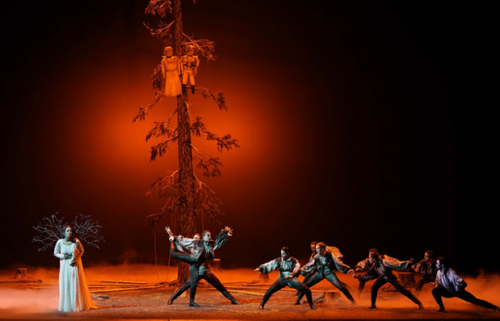 United Kingdom Bellini, La sonnambula: Soloists, Chorus and Orchestra of Teatro Real / Maurizio Benini (conductor). Teatro Real, Madrid, 18 and 19.12.2022. (JMI)
United Kingdom Bellini, La sonnambula: Soloists, Chorus and Orchestra of Teatro Real / Maurizio Benini (conductor). Teatro Real, Madrid, 18 and 19.12.2022. (JMI)

Production:
Director – Bárbara Lluch
Sets – Christof Hetzer
Costumes – Clara Peluffo
Lighting – Urs Schönebaum
Choreographer – Iratxe Ansa
Chorus director – Andrés Máspero
Cast:
Amina – Nadine Sierra / Jessica Pratt
Elvino – Xabier Anduaga / Francesco Demuro
Lisa – Rocío Pérez / Serena Sáenz
Rodolfo – Roberto Tagliavini / Fernando Radó
Teresa – Monica Bacelli / Gemma Coma-Alabert
Alessio – Isaac Galán
Notary – Gerardo López
The year 2022 ends at Teatro Real with these performances of La sonnambula which, along with Norma and I puritani, is among the three most-performed Bellini operas. Despite that, it has been almost 23 years since it was last seen in Madrid.
Teatro Real’s co-production (with New National Theatre Tokyo, Gran Teatre del Liceu Barcelona and Teatro Massimo Palermo) did not convince me. Its originality, according to statements by Bárbara Lluch, is the fact that the ending of the opera is left open, in the sense of the final union of Amina and Elvino being up in the air due to his bad behavior. This is not what the libretto says, and the truth is that Lluch’s interpretation was not clear to me on stage either.

The set is very simple. There is a tree in the center of the stage on which two dolls are hung, followed by a machine representing the Elvino mill. A house is added in the last scene, and Amina’s sleepwalking takes place on the roof. A novelty of the production is the addition of a group of ten dancers who accompany Amina in her sleepwalking scenes and at the start of the two acts. The stage direction seemed rather poor: the chorus is static, as if this were a concert version, and the soloists are on their own.
The musical direction was under the baton of Maurizio Benini, who is a true guarantee of success in these bel canto operas, as he has proved so many times. His reading was very careful, with perfect control of the pit and the stage, although the tension clearly dropped at times when he slowed down the tempi. The musical version that Maestro Benini offered is the longest I have witnessed. Both the orchestra and the chorus gave strong performances.
With the second cast, something changed in the musical direction: the length was much more normal and six minutes shorter than the day before.
The big triumph belonged to soprano Nadine Sierra, who was making her debut at Teatro Real and offered an admirable vocal and stage interpretation of Amina. She is a lyric soprano with an attractive voice and no problems throughout her full range, singing and expressing herself in an excellent fashion. One can understand why she has become one of the sopranos most in demand in the great opera houses.
The second Amina was Jessica Pratt, who was undoubtedly the strongest in the second cast, although her performance was below that of Nadine Sierra. Pratt knows the character perfectly, having sung the part many times, and she was particularly good in the aria ‘Ah, non credea mirarti’.
Tenor Xabier Anduaga was Elvino. I think he has ceased to be a promising young singer and is now a reality, and he should be treated and demanded as such. It is good to remember that this coming spring he will make his debut in Paris (I puritani) and at the Metropolitan Opera in New York (L’elisir d’amore). His voice has great quality: remarkable volume, brilliant projection, great homogeneity and no problems in the top notes, which are very bright. There are two aspects where he must improve in order to become an even greater artist, and they are elegance in phrasing and expressiveness, where he still leaves something to be desired.
The second Elvino was Francesco Demuro, who is vocally well-suited for the character’s demands. His singing technique is good, but the biggest problem is that his voice narrows in the higher notes. I clearly prefer Xabier Anduaga.
Bass Roberto Tagliavini offered a good interpretation of Count Rodolfo. Although his voice is not exceptional, he clearly dominates the character in vocal terms. In the second cast, Count Rodolfo was bass Fernando Radó, whom we have seen many times in secondary roles at Teatro Real. His performance was insufficient for the character, particularly in an opening aria where he was not applauded.
Soprano Rocío Pérez was Lisa, and her voice seemed to me more metallic than on other occasions, especially in the upper part. She sang the aria in Act II, which is omitted on some occasions. The second Lisa was soprano Serena Sáenz, who confirmed the very positive impression she had made on me on other occasions. Her voice is without tessitura problems, and she sings with gusto.
Monica Bacelli as Teresa did well. Gemma Coma-Alabert as Teresa was correct, as were both Isaac Galán’s Alessio and Gerardo López’s Notary.
Jose M. Irurzun

Can you please tell me what language and surtitle language was used?
S&H replies: Obviously the opera is in Italian and research suggests surtitles there are (Castilian) Spanish and English above the stage and on both sides of it.